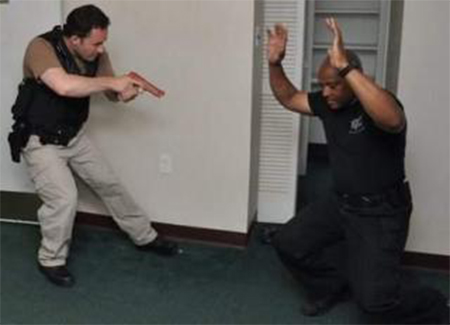
DAHLGREN, Va. – The Naval Support Activity South Potomac (NSASP) Police Department hosted police officers from Joint Base Anacostia-Bolling (JBAB) for advanced tactical training June 19-21. The training was intended to sharpen the officers’ skills in several areas, such as active shooter response. The mini-course included classroom time, practical application, night vision training, live-fire and time in the VirTra Systems simulator.
Bob Brooks, chief of NSASP police, was impressed with the JBAB police officers’ performance. “We offered this course to all the bases in the region, however only JBAB was able to send interested officers,” he said. “The officers that attended from JBAB did an outstanding job and definitely represented their department well. I, as well as all of the other instructors, were very impressed with their abilities, professionalism and enthusiasm.”
For the practical application portion of the course, the JBAB police officers conducted active-shooter response drills inside one of Dahlgren’s buildings. In a maze-like layout, with multiple opposing danger areas, safely is a challenge for any police officer. Though, training can be tailored to all skill levels.
Capt. Patrick Gardner, a police officer assigned to NSA Washington, added realism to the drills by role-playing the active shooter. Gardner fired at the JBAB officers with a blank-loaded pistol as the officers made entry into the facility. In pairs, the JBAB officers advanced, cleared rooms, eventually cornering the “bad guy” and taking him into custody.
MACS Chris Merz challenged the JBAB officers with several scenarios in the VirTra Systems simulator. The system, with three large screens that fill the trainee’s field of vision, is no mere video game; the training program “reacts” to trainees’ actions and a threat feedback feature lets officers know when they’ve been “shot” via a wireless electrical impulse device. One by one, the JBAB officers went through the scenario, with Merz making significant but subtle changes in between drills. Each officer went through a scenario without threat feedback before returning for drills that incorporated the feature.
One JBAB officer drew his weapon too late; his body contorted slightly as the virtual suspect “fired” and he received the threat feedback. Another officer, Cpl. John Reyes, completed his scenario without receiving any threat feedback, but he acknowledged the anxiety it caused with a relieved grin once he completed the drill.
It is exceedingly difficult to replicate the stress police officers experience in real-life encounters with suspects, but the threat feedback feature comes close. “People understand that there’s a level of separation between them and a TV screen,” Merz said. “So what you have to do to make the training realistic is raise [the trainees’] level of anticipation, raise their heart rates. A person’s brain goes into a fight or flight response in stressful situations and police officers have to train for that. When you have an adrenaline rush, your senses can shut down; first audio, then visual and eventually common sense thinking. Officers have one thing to rely on in those types of situations and that’s training.”
Virtual reality-based training helps police officers achieve that level of proficiency and does so economically. “The best thing about the system is that it allows us to minimize the amount of resources we have to expend in order to train officers,” Merz said, who has taken a lead role in operating the system since it was acquired last year. “While live-fire training is important, we can shoot thousands of simulated rounds in the VirTra System and train officers to a level that is commensurate with Navy standards. The system can also be customized to train to evolving security needs; it allows for growth.”
The time spent by the JBAB police officers in the simulator was only part of the mini-course, which covered a lot of ground in three days. Time was spent brushing up on other vital law enforcement skills, such as weapons retention.
The police officers from JBAB appreciated the chance to brush up on their law enforcement skills. “It’s fantastic training with advanced technical equipment and very diverse instructors with lots of experience,” said Sgt. Carlos Ansley, JBAB police officer. “No matter what skill level you’re at, you’re going to come here and you’re going to get quality training and learn something new, whether you’re a beginner or you’re an experienced officer. It’s very high-speed stuff.”
Military law enforcement faces a threat environment that is always changing. Achieving and maintaining a high level of proficiency is important for every police officer, especially with regard to the active shooter threat. “It’s very needed training,” Ansley said. “Every officer on the street who’s carrying a weapon and responding to calls should have at least a basic level knowledge of this type of training, so they’re prepared. [Police officers] need to have the correct combat mindset and know what level of force to use, depending on the threat they are faced with. If it’s the highest level of threat, they need to be able to respond with the highest level of force. That’s the kind of training we get here.”







